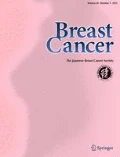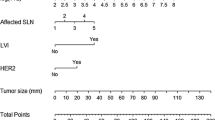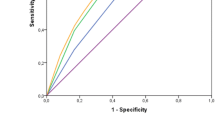Abstract
Background
Axillary staging is a significant prognostic factor often used to determine the treatment course for breast cancer. One-step nucleic acid amplification (OSNA) is now the most accepted method for intra-operative assessment of sentinel lymph nodes (SLN) as it can semi-quantitatively determine the tumor burden in these SLN. Axillary lymph node dissection (ALND) may be omitted in patients with limited disease in the axilla. The objective was to create nomogram for prediction of non-sentinel lymph node (NSLN) status using OSNA to avoid unnecessary ALND.
Patients and methods
Patients with invasive breast cancer T1–T3 and clinically negative axillary lymph nodes underwent SLN biopsy assessed by OSNA. The patients with positive SLN underwent ALND. Correlations between total tumor load (TTL), clinicopathological parameters, and NSLN status were analyzed by Chi square statistic and logistic regression. Model discrimination was evaluated using receiver-operating characteristic (ROC) analysis.
Results
The total number of patients who underwent SLN biopsies was 278. There were 89 patients with positive SLN. NSLNs were positive in 40 patients. Larger tumor size, presence of lymphovascular invasion (LVI) and higher log TTL were independent factors that predicted positive NSLN. TTL can discriminate NSLN status with area under the ROC curve of 0.789 (95% CI 0.686–0.892). Two nomograms using different parameters obtained pre- and post-operatively can predict NSLN involvement with better area under the ROC curve (0.801, 95% CI 0.702–0.900 and 0.849, 95% CI 0.766–0.932, respectively).
Conclusions
Nomograms using results obtained via OSNA can predict NSLN status, as well as aid in deciding to omit the use of ALND.



Similar content being viewed by others
References
Fisher B, Bauer M, Wickerham DL, Redmond CK, Fisher ER, Cruz AB, et al. Relation of number of positive axillary nodes to the prognosis of patients with primary breast cancer. An NSABP update. Cancer. 1983;52:1551–7.
Mohammed ZM, McMillan DC, Edwards J, Mallon E, Doughty JC, Orange C, et al. The relationship between lymphovascular invasion and angiogenesis, hormone receptors, cell proliferation and survival in patients with primary operable invasive ductal breast cancer. BMC Clin Pathol. 2013;13:31.
Krag DN, Anderson SJ, Julian TB, Brown AM, Harlow SP, Costantino JP, et al. Sentinel-lymph-node resection compared with conventional axillary-lymph-node dissection in clinically node-negative patients with breast cancer: overall survival findings from the NSABP B-32 randomised phase 3 trial. Lancet Oncol. 2010;11:927–33.
Lyman GH, Temin S, Edge SB, Newman LA, Turner RR, Weaver DL, et al. Sentinel lymph node biopsy for patients with early-stage breast cancer: American Society of Clinical Oncology clinical practice guideline update. J Clin Oncol. 2014;32:1365–83.
Goyal A, Newcombe RG, Chhabra A, Mansel RE. Morbidity in breast cancer patients with sentinel node metastases undergoing delayed axillary lymph node dissection (ALND) compared with immediate ALND. Ann Surg Oncol. 2008;15:262–7.
Layfield DM, Agrawal A, Roche H, Cutress RI. Intraoperative assessment of sentinel lymph nodes in breast cancer. Br J Surg. 2011;98:4–17.
Donker M, van Tienhoven G, Straver ME, Meijnen P, van de Velde CJ, Mansel RE, et al. Radiotherapy or surgery of the axilla after a positive sentinel node in breast cancer (EORTC 10981-22023 AMAROS): a randomised, multicentre, open-label, phase 3 non-inferiority trial. Lancet Oncol. 2014;15:1303–10.
Giuliano AE, Ballman KV, McCall L, Beitsch PD, Brennan MB, Kelemen PR, et al. Effect of axillary dissection vs no axillary dissection on 10-year overall survival among women with invasive breast cancer and sentinel node metastasis: the ACOSOG Z0011 (Alliance) randomized clinical trial. JAMA. 2017;318:918–26.
Guven HE, Dogan L, Kulturoglu MO, Gulcelik MA, Ozaslan C. Factors influencing non-sentinel node metastasis in patients with macrometastatic sentinel lymph node involvement and validation of three commonly used nomograms. Eur J Breast Health. 2017;13:189–93.
Jakub JW, Bryant K, Huebner M, Hoskin T, Boughey JC, Reynolds C, et al. The number of axillary lymph nodes involved with metastatic breast cancer does not affect outcome as long as all disease is confined to the sentinel lymph nodes. Ann Surg Oncol. 2011;18:86–93.
Kohrt HE, Olshen RA, Bermas HR, Goodson WH, Wood DJ, Henry S, et al. New models and online calculator for predicting non-sentinel lymph node status in sentinel lymph node positive breast cancer patients. BMC Cancer. 2008;8:66.
Pal A, Provenzano E, Duffy SW, Pinder SE, Purushotham AD. A model for predicting non-sentinel lymph node metastatic disease when the sentinel lymph node is positive. Br J Surg. 2008;95:302–9.
Tsujimoto M, Nakabayashi K, Yoshidome K, Kaneko T, Iwase T, Akiyama F, et al. One-step nucleic acid amplification for intraoperative detection of lymph node metastasis in breast cancer patients. Clin Cancer Res. 2007;13:4807–16.
Visser M, Jiwa M, Horstman A, Brink AA, Pol RP, van Diest P, et al. Intra-operative rapid diagnostic method based on CK19 mRNA expression for the detection of lymph node metastases in breast cancer. Int J Cancer. 2008;122:2562–7.
Chaudhry A, Williams S, Cook J, Jenkins M, Sohail M, Calder C, et al. The real-time intra-operative evaluation of sentinel lymph nodes in breast cancer patients using one step nucleic acid amplification (OSNA) and implications for clinical decision-making. Eur J Surg Oncol. 2014;40:150–7.
Deambrogio C, Castellano I, Paganotti A, Zorini EO, Corsi F, Bussone R, et al. A new clinical cut-off of cytokeratin 19 mRNA copy number in sentinel lymph node better identifies patients eligible for axillary lymph node dissection in breast cancer. J Clin Pathol. 2014;67:702–6.
Heilmann T, Mathiak M, Hofmann J, Mundhenke C, van Mackelenbergh M, Alkatout I, et al. Intra-operative use of one-step nucleic acid amplification (OSNA) for detection of the tumor load of sentinel lymph nodes in breast cancer patients. J Cancer Res Clin Oncol. 2013;139:1649–55.
Peg V, Espinosa-Bravo M, Vieites B, Vilardell F, Antunez JR, de Salas MS, et al. Intraoperative molecular analysis of total tumor load in sentinel lymph node: a new predictor of axillary status in early breast cancer patients. Breast Cancer Res Treat. 2013;139:87–93.
Terrenato I, D’Alicandro V, Casini B, Perracchio L, Rollo F, De Salvo L, et al. A cut-off of 2150 cytokeratin 19 mRNA copy number in sentinel lymph node may be a powerful predictor of non-sentinel lymph node status in breast cancer patients. PLoS One. 2017;12:e0171517.
Rubio IT, Espinosa-Bravo M, Rodrigo M, Amparo Viguri Diaz M, Hardisson D, Sagasta A, et al. Nomogram including the total tumoral load in the sentinel nodes assessed by one-step nucleic acid amplification as a new factor for predicting nonsentinel lymph node metastasis in breast cancer patients. Breast Cancer Res Treat. 2014;147:371–80.
Shimazu K, Sato N, Ogiya A, Sota Y, Yotsumoto D, Ishikawa T, et al. Intraoperative nomograms, based on one-step nucleic acid amplification, for prediction of non-sentinel node metastasis and four or more axillary node metastases in breast cancer patients with sentinel node metastasis. Ann Surg Oncol. 2018;25:2603–11.
Khaddage A, Berremila SA, Forest F, Clemenson A, Bouteille C, Seffert P, et al. Implementation of molecular intra-operative assessment of sentinel lymph node in breast cancer. Anticancer Res. 2011;31:585–90.
Osako T, Iwase T, Kimura K, Yamashita K, Horii R, Yanagisawa A, et al. Intraoperative molecular assay for sentinel lymph node metastases in early stage breast cancer: a comparative analysis between one-step nucleic acid amplification whole node assay and routine frozen section histology. Cancer. 2011;117:4365–74.
Snook KL, Layer GT, Jackson PA, de Vries CS, Shousha S, Sinnett HD, et al. Multicentre evaluation of intraoperative molecular analysis of sentinel lymph nodes in breast carcinoma. Br J Surg. 2011;98:527–35.
Shi F, Liang Z, Zhang Q, Wang C, Liu X. The performance of one-step nucleic acid amplification assay for intraoperative detection of sentinel lymph node macrometastasis in breast cancer: an updated meta-analysis. Breast. 2018;39:39–45.
Nabais C, Figueiredo J, Lopes P, Martins M, Araujo A. Total tumor load assessed by one-step nucleic acid amplification assay as an intraoperative predictor for non-sentinel lymph node metastasis in breast cancer. Breast. 2017;32:33–6.
Espinosa-Bravo M, Sansano I, Perez-Hoyos S, Ramos M, Sancho M, Xercavins J, et al. Prediction of non-sentinel lymph node metastasis in early breast cancer by assessing total tumoral load in the sentinel lymph node by molecular assay. Eur J Surg Oncol. 2013;39:766–73.
Kubota M, Komoike Y, Hamada M, Shinzaki W, Azumi T, Hashimoto Y, et al. One-step nucleic acid amplification assay for intraoperative prediction of advanced axillary lymph node metastases in breast cancer patients with sentinel lymph node metastasis. Mol Clin Oncol. 2016;4:173–8.
Yoshihara E, Smeets A, Laenen A, Reynders A, Soens J, Van Ongeval C, et al. Predictors of axillary lymph node metastases in early breast cancer and their applicability in clinical practice. Breast. 2013;22:357–61.
Christine K, Reilly S, Charles M, Martin R, Sanford R, Thomas S, et al. Significant discordance of lymphovascular invasion between breast cancer core biopsies and surgical specimens limits its role as a tool for preoperative prediction of nodal metastasis. In: The American society of breast surgeons 18th Annual Meeting April 26–30, 2017, Las Vegas, NV. 2017. Available at: https://www.breastsurgeons.org/docs2017/posters/ASBrS_2017_Poster_256753.pdf. Accessed 25 Dec 2018.
Gruber IV, Rueckert M, Kagan KO, Staebler A, Siegmann KC, Hartkopf A, et al. Measurement of tumour size with mammography, sonography and magnetic resonance imaging as compared to histological tumour size in primary breast cancer. BMC Cancer. 2013;13:328.
Acknowledgements
This study was supported by Siriraj Research and Development Fund and Sysmex Asia-Pacific Pte Ltd.
Funding
Siriraj Research and Development Fund. Sysmex Asia-Pacific Pte Ltd.
Author information
Authors and Affiliations
Corresponding author
Ethics declarations
Conflict of interest
The authors declared no conflict of interest. Sysmex Asia-Pacific Pte Ltd. had no influence in the analysis and interpretation of the results.
Additional information
Publisher’s Note
Springer Nature remains neutral with regard to jurisdictional claims in published maps and institutional affiliations.
About this article
Cite this article
Sa-nguanraksa, D., O-charoenrat, E., Kulprom, A. et al. Nomogram to predict non-sentinel lymph node status using total tumor load determined by one-step nucleic acid amplification: first report from Thailand. Breast Cancer 26, 471–477 (2019). https://doi.org/10.1007/s12282-019-00945-8
Received:
Accepted:
Published:
Issue Date:
DOI: https://doi.org/10.1007/s12282-019-00945-8




